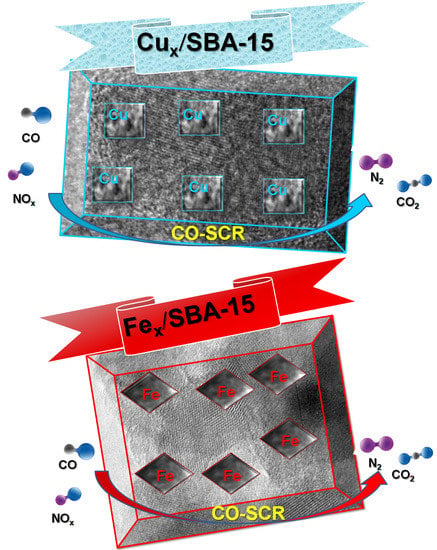Selective Catalytic Reduction of NOx by CO over Cu(Fe)/SBA-15 Catalysts: Effects of the Metal Loading on the Catalytic Activity
Abstract
:1. Introduction
2. Results and Discussion
2.1. Physicochemical Characterizations
2.2. Raman and EPR Measurements
2.3. Morphology and Structure
2.4. Catalytic Results
2.4.1. Effect of the Temperature, and NOx to CO Molar Ratios
2.4.2. Effect of the Oxygen Concentrations
2.4.3. Effect of H2O and SO2 Poisons
3. Materials and Methods
3.1. Materials
3.2. Catalyst Preparation
3.3. Catalyst Characterizations
3.4. Catalytic Evaluation in CO-SCR Reaction
4. Conclusions
Supplementary Materials
Author Contributions
Funding
Data Availability Statement
Acknowledgments
Conflicts of Interest
References
- Xue, H.; Guo, X.; Mao, D.; Meng, T.; Yu, J.; Ma, Z. Phosphotungstic acid-modified MnOx for selective catalytic reduction of NOx with NH3. Catalysts 2022, 12, 1248. [Google Scholar] [CrossRef]
- Lin, D.; Zhang, L.; Liu1, Z.; Wang, B.; Han, Y. Progress of selective catalytic reduction denitrification catalysts at wide temperature in carbon neutralization. Front. Chem. 2022, 10, 946133. [Google Scholar] [CrossRef]
- Nascimento, J.P.S.; Oton, L.F.; Oliveira, A.C.; Rodríguez-Aguado, E.; Rodríguez-Castellón, E.; Araujo, R.S.; Souza, S.M.; Lang, R. Selective catalytic reduction of NOx by CO over doubly promoted MeMo/Nb2O5 catalysts (Me = Pt, Ni, or Co). Catalysts 2020, 10, 1048. [Google Scholar] [CrossRef]
- Mrad, R.; Aissat, A.; Primo, R.; Courcot, D.; Siffert, S. Catalysts for NOx selective catalytic reduction by hydrocarbons (HC-SCR). Appl. Catal. 2015, 504, 542–548. [Google Scholar] [CrossRef]
- Zhang, Y.; Zhao, L.; Kang, M.; Chen, Z.; Gao, S.; Hao, H. Insights into high CO-SCR performance of CuCoAlO catalysts derived from LDH/MOFs composites and study of H2O/SO2 and alkali metal resistance. Chem. Eng. J. 2021, 426, 131873. [Google Scholar] [CrossRef]
- Souza, M.S.; Araújo, R.S.; Oliveira, A.C. Optimizing reaction conditions and experimental studies of selective catalytic reduction of NO by CO over supported SBA-15 catalyst. Environm. Sci. Pollution Res. 2020, 27, 30649–30660. [Google Scholar] [CrossRef] [PubMed]
- Zang, P.; Liu, J.; Zhang, G.; Jia, B.; He, Y.; Wang, Y.; Lv, Y. Insights into the highly activity CuMgFe oxides for the selective catalytic reduction of NO by CO: Structure-activity relationships and K/SO2 poisoning mechanism. Fuel 2023, 331, 125800. [Google Scholar] [CrossRef]
- Nascimento, J.P.S.; Oliveira, A.C.; Araujo, J.C.S.; Sousa, F.F.; Saraiva, G.D.; Rodríguez-Aguado, E.; Rodríguez-Castellón, E. Combined promoting effect of molybdenum on the bimetallic Al2O3-La2O3 catalysts for NOx reduction by CO. Fuel 2020, 275, 117872. [Google Scholar] [CrossRef]
- Boutros, M.; Trichard, J.; Costa, P. Silver supported mesoporous SBA-15 as potential catalysts for SCR NOx by etanol. Appl. Catal. 2009, 91, 640–648. [Google Scholar] [CrossRef]
- Damma, D.; Ettireddy, P.R.; Reddy, B.M.; Smirniotis, P.G. A review of low temperature NH3-SCR for removal of NOx. Catalysts 2019, 9, 349. [Google Scholar] [CrossRef] [Green Version]
- Selleria, T.; Nova, I.; Tronconia, E.; Schmeisserb, V.; Seher, S. The impact of light and heavy hydrocarbons on the NH3-SCR activity of commercial Cu- and Fe-zeolite catalysts. Catal. Today 2019, 320, 100–111. [Google Scholar] [CrossRef]
- Zhang, R.; Shi, D.; Zhao, Y.; Chen, B.; Xue, J.; Liang, X.; Lei, Z. The reaction of NO + C3H6 + O2 over the mesoporous SBA-15 supported transition metal catalysts. Catal. Today 2011, 175, 26–33. [Google Scholar] [CrossRef]
- Patel, A.; Thomas, R.E.; Rudolph, V.; Zhu, Z. Selective catalytic reduction of NO by CO over CuO supported on SBA-15: Effect of CuO loading on the activity of catalysts. Catal. Today 2011, 166, 188–193. [Google Scholar] [CrossRef]
- Guo, K.; Jiaweia, J.; Osuga, R.; Zhu, Y.; Sun, J.; Tang, C.; Kondo, J.N.; Dong, L. Construction of Fe2O3 loaded and mesopore confined thin-layer titania catalyst for efficient NH3-SCR of NOx with enhanced H2O/SO2 tolerance. Appl. Catal. 2021, 287, 119982. [Google Scholar] [CrossRef]
- Tsoncheva, T.; Gallo, A.; Genova, I.; Spassova, I.; Marelli, M.; Dimitrov, M.; Khristova, M.; Atanasova, G.; Kovacheva, D.; Nihtyanova, D.; et al. Control of copper particles deposition in mesoporous SBA-15 silica by modified CVD method. Inorganica Chim. Acta. 2014, 423, 145–151. [Google Scholar] [CrossRef]
- Jankowska, A.; Kowalczyk, A.; Rutkowska, M.; Michalik, M.; Chmielarz, L. Catalytic performance of bimetallic systems (Cu-Fe, Cu-Mn, Fe-Mn) based on spherical MCM-41 modified by template ion-exchange in NH3-SCR process. Catalysts 2022, 12, 885. [Google Scholar] [CrossRef]
- Rivera-Jiménez, S.M.; Méndez-González, S.; Hernández-Maldonado, A. Metal (M = Co2+, Ni2+, and Cu2+) grafted mesoporous SBA-15: Effect of transition metal incorporation and pH conditions on the adsorption of Naproxen from water. Microp. Mesop. Mater. 2010, 132, 470–479. [Google Scholar] [CrossRef]
- Miao, K.; Luo, X.; Wang, W.; Guo, J.; Guo, S.; Cao, F.; Hu, Y.; Chang, P.; Feng, G. One-step synthesis of Cu–SBA-15 under neutral condition and its oxidation catalytic performance. Microp. Mesop. Mater. 2019, 289, 109640. [Google Scholar] [CrossRef]
- Shen, W.; Mao, D.; Luo, Z.; Yu, J. CO oxidation on mesoporous SBA-15 supported CuO–CeO2 catalyst prepared by a surfactant-assisted impregnation method. RSC Adv. 2017, 7, 27689–27698. [Google Scholar] [CrossRef] [Green Version]
- Gu, Z.; Cheng, L.; Tan, C.; Sin, S.; Huang, C.; Tang, C. Enriching SO42− Immobilization on α-Fe2O3 via Spatial Confinement for Robust NH3-SCR Denitration. Catalysts 2022, 12, 991. [Google Scholar] [CrossRef]
- Kumar, M.S.; Pérez-Ramíre, J.; Debbagh, M.N.; Smarsly, B.; Bentrup, U.; Brückner, A. Evidence of the vital role of the pore network on various catalytic conversions of N2O over Fe-silicalite and Fe-SBA-15 with the same iron constitution. Appl. Catal. 2006, 62, 244–254. [Google Scholar] [CrossRef]
- Kuśtrowski, P.; Chmielarz, L.; Surman, J.; Bidzińska, E.; Dziembaj, R.; Cool, P.; Vansant, E.F. Catalytic activity of MCM-48-, SBA-15-, MCF-, and MSU-type mesoporous silicas modified with Fe3+ species in the oxidative dehydrogenation of ethylbenzene in the presence of N2O. J. Phys. Chem. 2005, 109, 9808–9815. [Google Scholar] [CrossRef]
- Volanti, D.P.; Keyson, D.; Cavalcante, L.S.; Simões, A.Z.; Joya, M.R.; Longo, E.; Varela, P.S.; Pizani, P.S.; Souza, A.G. Synthesis and characterization of CuO flower-nanostructure processing by a domestic hydrothermal microwave. J. Alloys Compd. 2008, 459, 537–542. [Google Scholar] [CrossRef]
- Carmo, J.V.C.; Bezerra, R.C.F.; Tehuacanero-Cuapa, S.; Rodríguez-Aguado, E.; Lang, R.; Campos, A.F.; Duarte, G.; Saraiva, G.D.; Otubo, L.; Oliveira, A.C.; et al. Synthesis of tailored alumina supported Cu-based solids obtained from nanocomposites: Catalytic application for valuable aldehyde and ketones production. Mater. Chem. Phys. 2022, 292, 126800. [Google Scholar] [CrossRef]
- Tsoncheva, T.; Issaa, G.; Blasco, T.; Dimitrov, M.; Popova, M.; Hernández, S.; Kovacheva, D.; Atanasova, G.; Nieto, J.M.L. Catalytic VOCs elimination over copper and cerium oxide modified mesoporous SBA-15 silica. Appl. Catal. 2013, 453, 1–12. [Google Scholar] [CrossRef] [Green Version]
- Dantas, N.O.; Ayta, W.E.F.; Silva, A.; Cano, N.F.; Silva, S.W.; Morais, P.C. Effect of Fe2O3 concentration on the structure of the SiO2–Na2O–Al2O3–B2O3 glass system. Spectrochim. Acta A Mol. Biomol. Spectrosc. 2011, 81, 140–143. [Google Scholar] [CrossRef]
- López-Sánchez, J.; Serrano, A.; Campo, A.; Abuín, M.; Fuente, O.R.; Carmona, N. Sol–gel synthesis and micro-Raman characterization of ε-Fe2O3 Micro- and nanoparticles. Chem. Mater. 2016, 28, 511–518. [Google Scholar] [CrossRef]
- Cruz, M.G.A.; Fernandes, F.A.N.; Oliveira, A.C.; Filho, J.M.; Oliveira, A.C.; Campos, A.F.; Padron-Hernandez, E.; Rodríguez-Castellón, E. Effect of the calcination temperatures of the Fe-based catalysts supported on polystyrene mesoporous carbon for FTS synthesis. Catal. Today 2017, 282, 174–184. [Google Scholar] [CrossRef]
- Jubb, A.M.; Allen, H.C. Vibrational spectroscopic characterization of hematite, maghemite, and magnetite thin films produced by vapor deposition. ACS Appl. Mater. Interfaces. 2010, 2, 2804–2812. [Google Scholar] [CrossRef]
- Li, Y.; An, D.; Zhang, Q.; Wang, Y. Copper-catalyzed selective oxidation of methane by oxygen: Studies on catalytic behavior and functioning mechanism of CuOx/SBA-15. J. Phys. Chem. C 2008, 112, 13700–13708. [Google Scholar] [CrossRef]
- Popova, M.; Szegedi, A.; Cherkezov-Zheleva, Z.; Dimitrova, A.; Mitov, I. Toluene oxidation on chromium- and copper-modified SiO2 and SBA-15. Appl. Catal. 2010, 381, 26–35. [Google Scholar] [CrossRef]
- Guang-Shea, L.; Li-Pinga, L.; Smith, R.L.; Inomata, H. Characterization of the dispersion process for NiFe2O4 nanocrystals in a silica matrix with infrared spectroscopy and electron paramagnetic resonance. J. Mol. Struct. 2001, 560, 87–93. [Google Scholar] [CrossRef]
- Jahagirdar, A.A.; Dhananjaya, N.; Monika, D.L.; Kesavulu, C.R.; Nagabhushana, H.; Sharma, S.C.; Nagabhushana, B.M.; Shivakumara, C.; Rao, J.L.; Chakradhar, R.P.S. Structural, EPR, optical and magnetic properties of a-Fe2O3 nanoparticles. Acta A Mol. Biomol. Spectrosc. 2013, 104, 512–518. [Google Scholar] [CrossRef] [PubMed]
- Zhang, L.; Zhao, Y.; Dai, H.; He, H.; Au, C.T. A comparative investigation on the properties of Cr-SBA-15 and CrOx/SBA-15. Catal. Today 2008, 131, 42–54. [Google Scholar] [CrossRef]
- Karthikeyan, S.; Pachamuthu, M.P.; Isaacs, M.A.; Kumar, S.; Lee, A.F.; Sekaran, G. Cu and Fe oxides dispersed on SBA-15: A Fenton type bimetallic catalyst for N,N-diethyl-p-phenylenediamine degradation. Appl. Catal. 2016, 199, 323–330. [Google Scholar] [CrossRef] [Green Version]
- Gütlich, P.; Bill, E.; Trautwein, A.X. Mössbauer Spectroscopy and Transition Metal Chemistry; Springer: Berlin/Heidelberg, Germany, 2011. [Google Scholar]
- Ge, X.; Li, M.; Shen, J. The Reduction of Mg-Fe-O and Mg-Fe-Al-OComplex Oxides Studied by Temperature-Programmed Reduction Combined with in Situ Mossbauer Spectroscopy. J. Solid State Chem. 2001, 161, 38–44. [Google Scholar] [CrossRef]
- Bødker, F.; Hansen, M.F.; Koch, C.B.; Lefmann, K.; Mørup, S. Magnetic properties of hematite nanoparticles. Phys. Rev. B. 2000, 61, 6826–6838. [Google Scholar] [CrossRef] [Green Version]
- Ji, M.; Chen, G.; Wang, J.; Wang, X.; Zhang, T. Dehydrogenation of ethylbenzene to styrene with CO2 over iron oxide-based catalysts. Catal. Today. 2010, 158, 464–469. [Google Scholar] [CrossRef]
- Cullity, B.D.; Graham, C.D. Introduction to Magnetic Materials, 2nd ed.; IEEE Press and John Wiley & Sons, Inc.: Hoboken, NJ, USA, 2009. [Google Scholar]
- Bachari, K.; Millet, J.M.M.; Bonville, P.; Cherifi, O.; Figueras, F. Spectroscopic characterization of iron nanoparticles in Fe-mesoporous silicate catalysts. J. Catal. 2007, 249, 52–58. [Google Scholar] [CrossRef]
- Neto, A.B.S.; Oliveira, A.C.; Rodriguez-Castellón, E.; Campos, A.F.; Freire, P.T.C.; Sousa, F.F.S.; Filho, J.M.; Araujo, J.C.S.; Rossano Lang, R. A comparative study on porous solid acid oxides as catalysts in the esterification of glycerol with acetic acid. Catal. Today 2020, 349, 57–67. [Google Scholar] [CrossRef]
- Gamarra, D.; Munuera, G.; Hungría, A.B.; Fernández-García, M.; Conesa, J.C.; Midgley, P.A.; Wang, X.Q.; Hanson, J.C.; Rodríguez, J.A.; Martínez-Arias, A. Structure-activity relationship in nanostructured copper ceria based preferential CO oxidation. J. Phys. Chem. C 2007, 111, 11026. [Google Scholar] [CrossRef]
- Moulder, J.F.; Stickle, W.F.; Sobel, P.E.; Bomben, K.D. Handbook of X-ray Photoelectron Spectrocopy; Chastain, J., Ed.; Perkin-Elmer: Eden Prairie, MN, USA, 1992. [Google Scholar]
- Ou, X.; Chen, K.; Wei, L.; Deng, Y.; Li, J.; Li, B.; Dong, L. Effect of Co doping on magnetic and CO-SCR properties of γ-Fe2O3. Ind. Eng. Chem. Res. 2021, 60, 5744–5757. [Google Scholar] [CrossRef]
- Wang, D.; Huang, B.; Shi, Z.; Long, H.; Li, L.; Yang, Z.; Dai, M. Influence of cerium doping on Cu–Ni/activated carbon low-temperature CO-SCR denitration catalysts. RSC Adv. 2021, 11, 18458–18467. [Google Scholar] [CrossRef] [PubMed]
- Patel, A.; Shukla, P.; Rufford, T.; Wang, S.; Chen, J.; Rudolph, V.; Zhu, Z. Catalytic reduction of NO by CO over copper-oxide supported mesoporous silica. Appl. Catal. A. Gen 2011, 409–410, 55–65. [Google Scholar] [CrossRef]
- Chen, X.; Liu, Y.; Liu, Y.; Lian, D.; Chen, M.; Ji, Y.; Xing, L.; Wu, K.; Liu, S. Recent advances of Cu-based catalysts for NO reduction by CO under O2-containing conditions. Catalysts 2022, 12, 1402. [Google Scholar] [CrossRef]
- Oton, L.F.; Oliveira, A.C.; Araujo, J.C.; Araujo, R.S.; De Sousa, F.F.; Saraiva, G.D.; Lang, R.; Otubo, L.; Duarte, G.C.D.S.; Campos, A. Selective catalytic reduction of NOx by CO (CO-SCR) over metal-supported nanoparticles dispersed on porous alumina. Adv. Powder Technol. 2020, 31, 464–476. [Google Scholar] [CrossRef]
- Bai, Y.; Bian, X.; Wu, W. Catalytic properties of CuO/CeO2-Al2O3 catalysts for low concentration NO reduction with CO. Appl. Surf. Sci. 2019, 463, 435–444. [Google Scholar] [CrossRef]
- Nova, I.; Lietti, L.; Forzatti, P.; Frola, F.; Prinetto, F.; Giovanna Ghiott, G. Reaction pathways in the reduction of NOx species by CO over Pt–Ba/Al2O3: Lean NOx trap catalytic systems. Top Catal. 2009, 52, 1757–1761. [Google Scholar] [CrossRef]
- Ye, D.; Ren, X.; Qu, R.; Liu, S.; Zheng, C.; Gao, X. Designing SO2-resistant cerium-based catalyst by modifying with Fe2O3 for the selective catalytic reduction of NO with NH3. Mol. Catal. 2019, 462, 10–18. [Google Scholar] [CrossRef]
- Palomares, A.E.; López-Nieto, J.M.; Lázaro, F.J.; López, A.; Corma, A. Reactivity in the removal of SO2 and NOx on Co/Mg/Al mixed oxides derived from hydrotalcites. Appl. Catal. 1999, 20, 257–266. [Google Scholar] [CrossRef]
- Fan, B.; Zhang, Z.; Liu, C.; Liu, Q. Investigation of sulfated iron-based catalysts with different sulfate position for selective catalytic reduction of NOx with NH3. Catalysts 2020, 10, 1035. [Google Scholar] [CrossRef]
- Zhu, M.; Wachs, I.E. Iron-based catalysts for the high-temperature water–gas shift (HT-WGS) reaction: A Review. ACS Catal. 2016, 6, 722–732. [Google Scholar] [CrossRef]
- Gao, C.; Shi, J.-W.; Fan, Z.; Gao, G.; Niu, C. Sulfur and water resistance of Mn-based catalysts for low-temperature selective catalytic reduction of NOx: A Review. Catalysts 2018, 8, 11. [Google Scholar] [CrossRef] [Green Version]
- Ilieva, L.; Pantaleo, G.; Velinov, N.; Tabakova, T.; Petrova, P.; Ivanov, I.; Avdeev, G.; Paneva, D.; Venezia, A.M. NO reduction by CO over gold catalysts supported on Fe-loaded ceria. Appl. Catal 2015, 174–175, 176–184. [Google Scholar] [CrossRef]
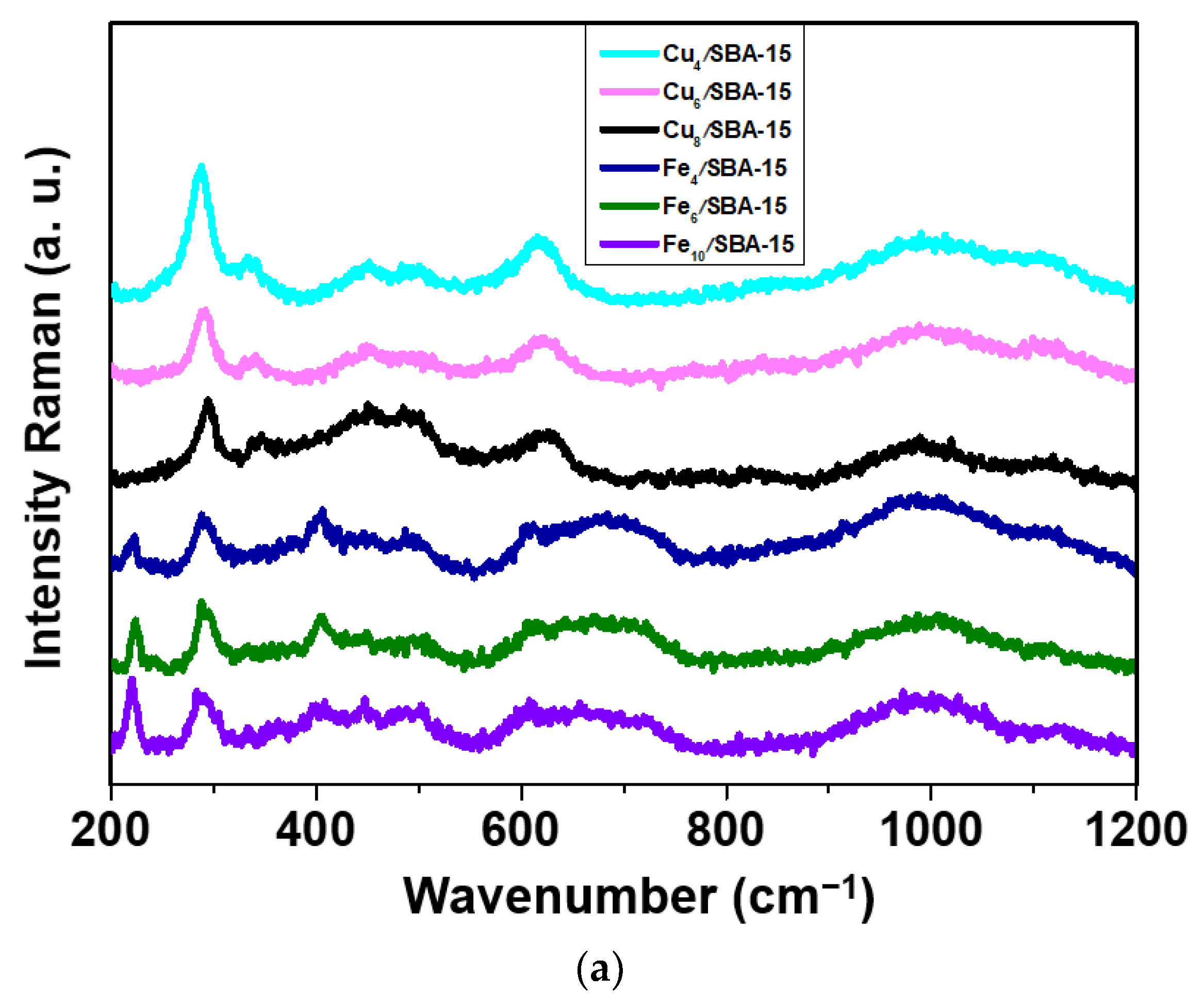
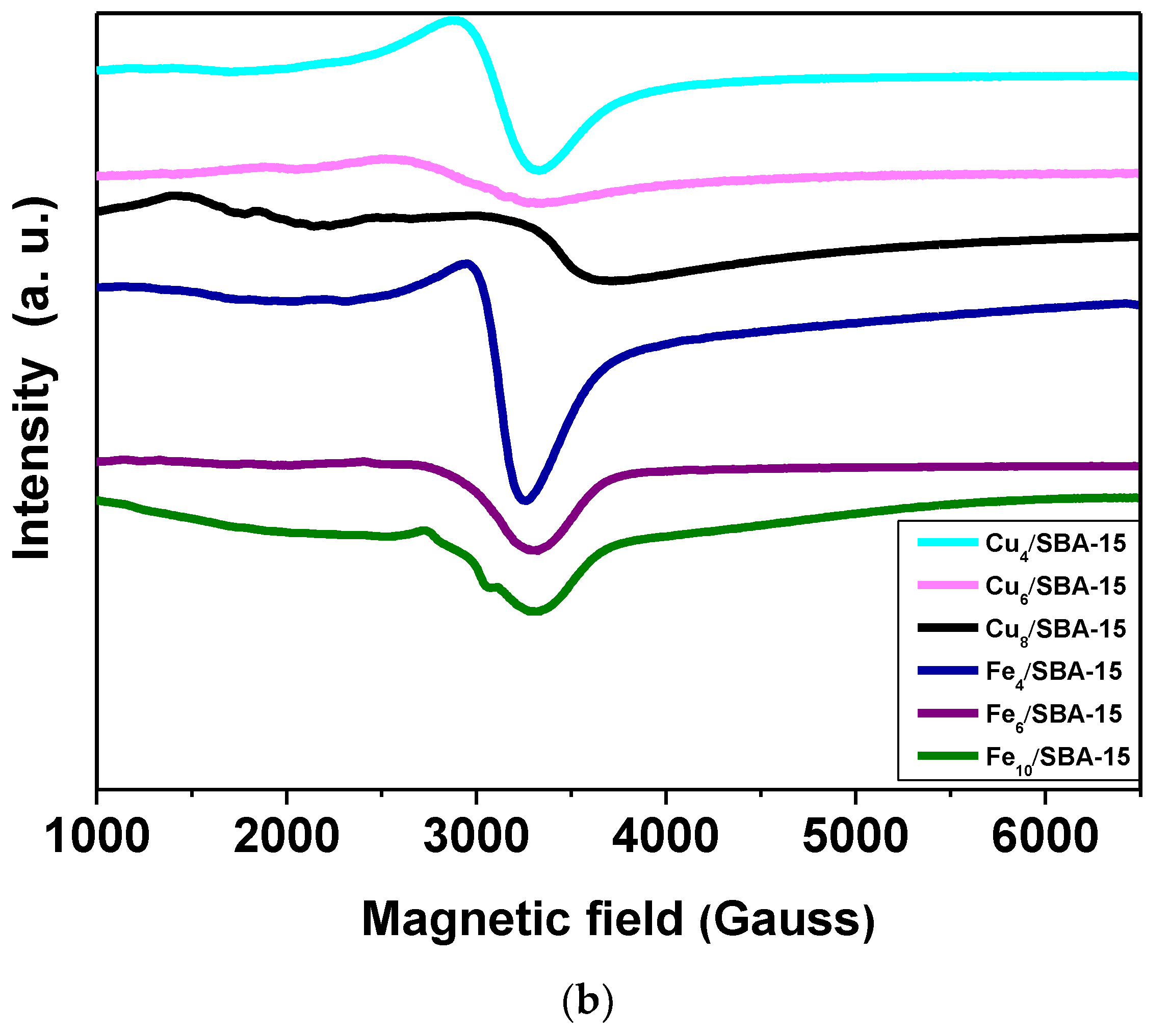
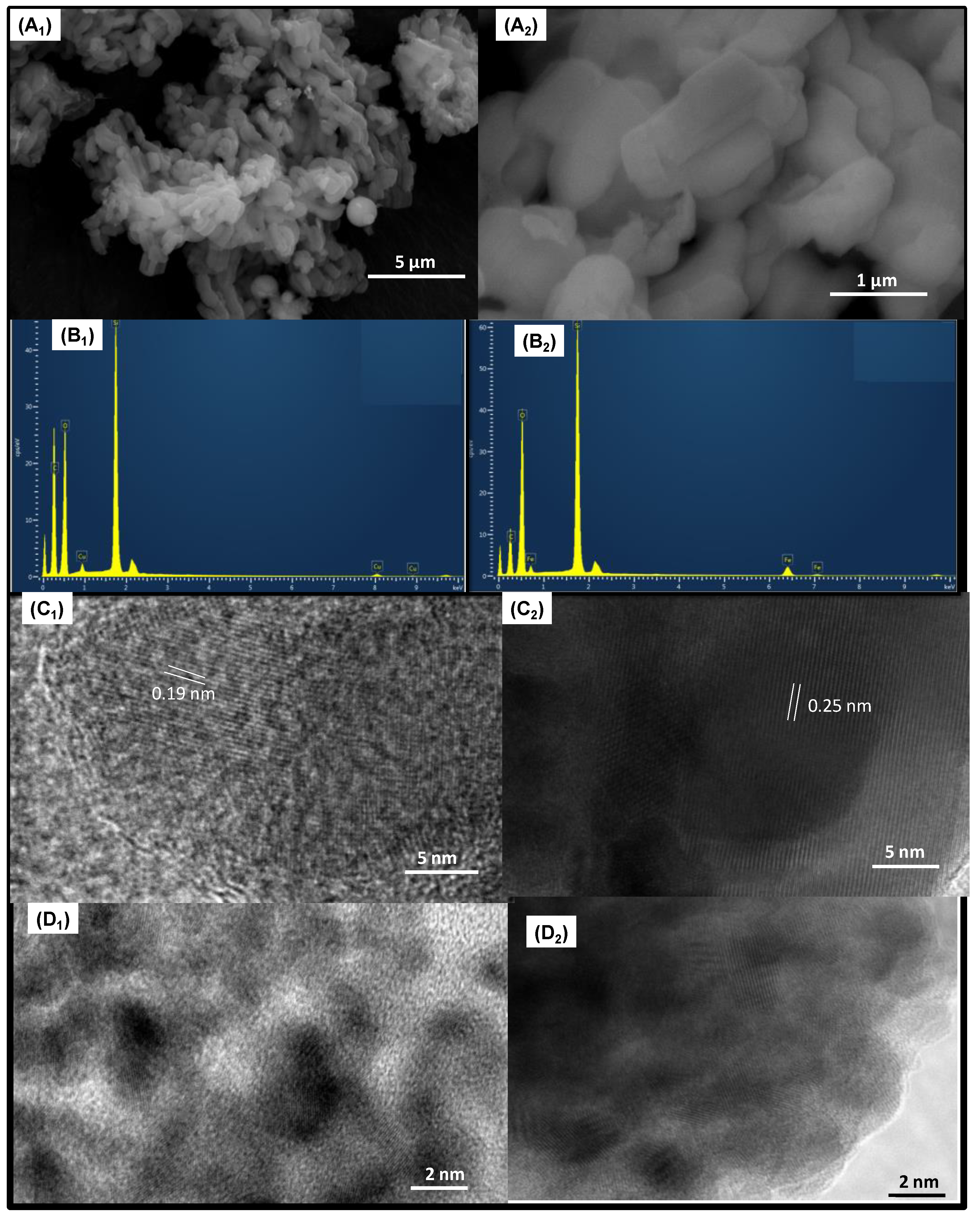



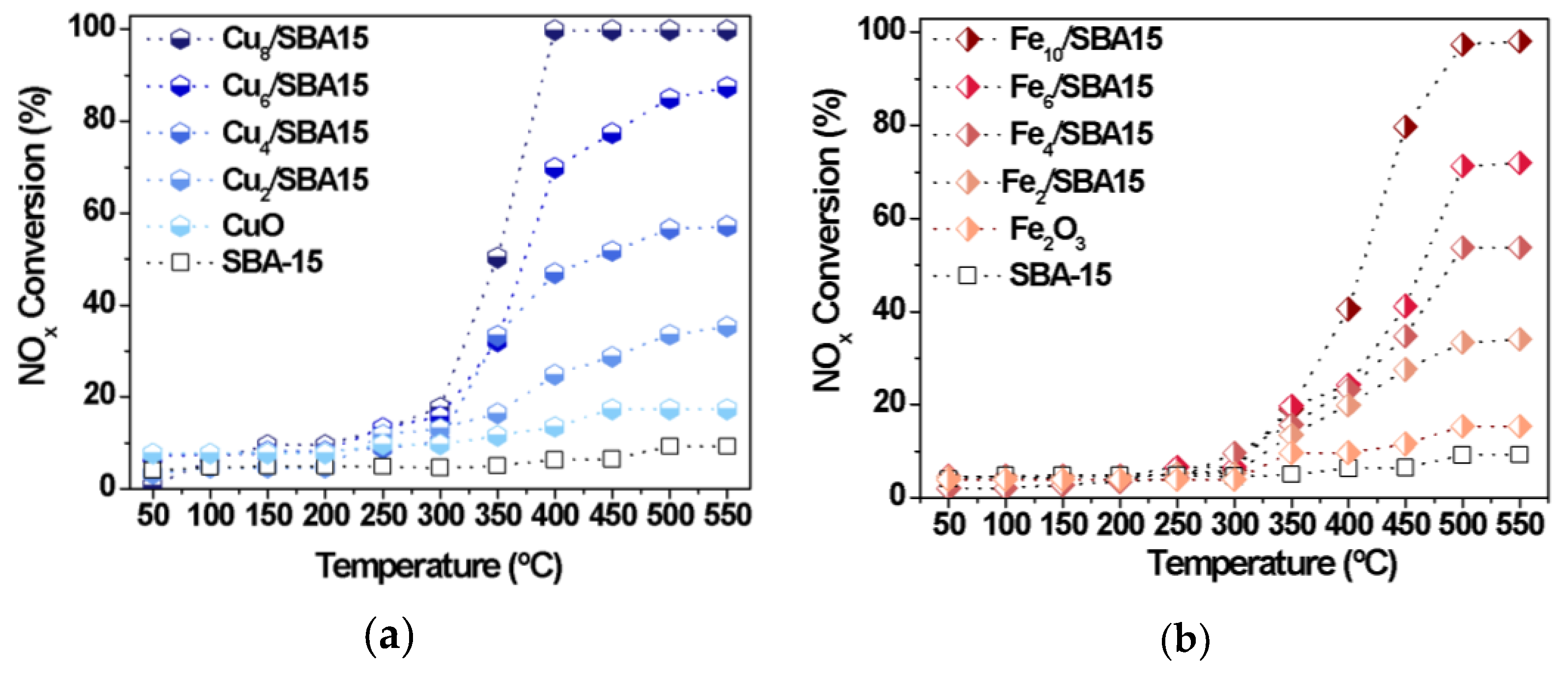
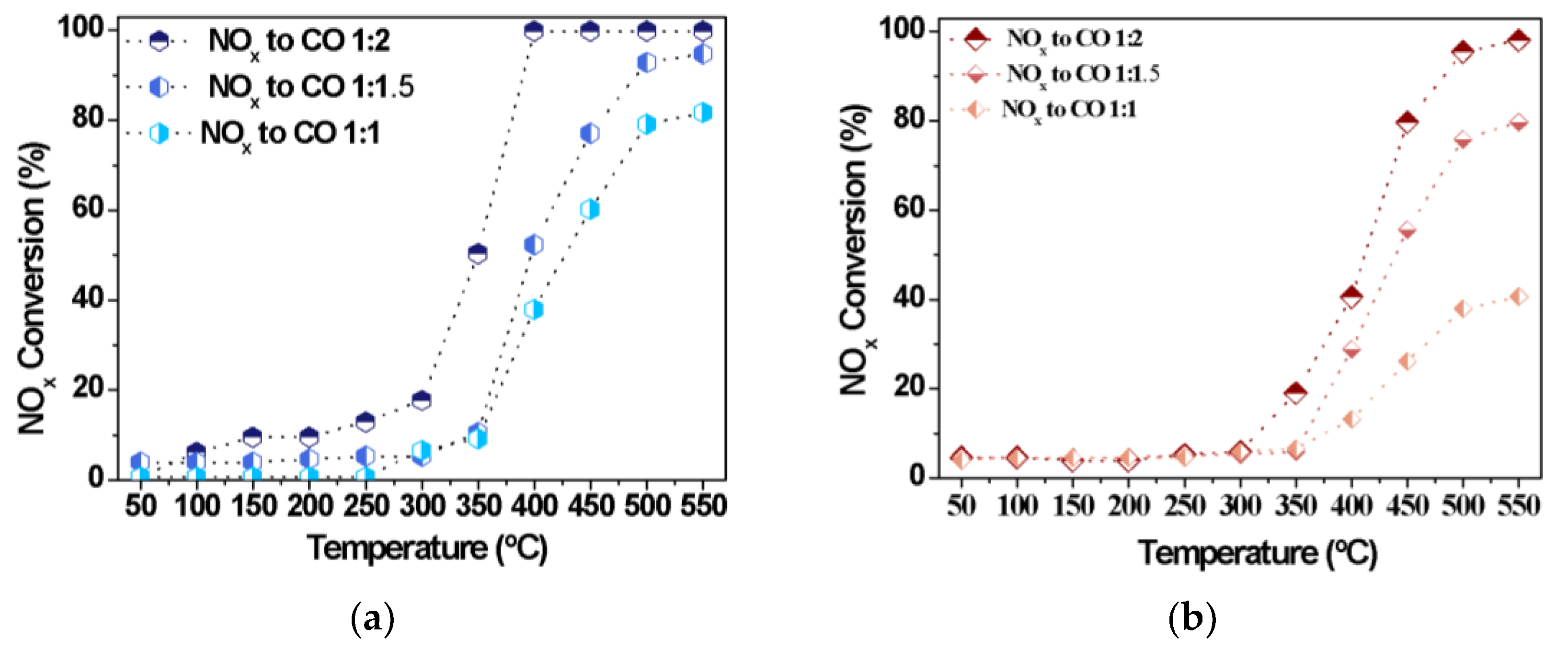
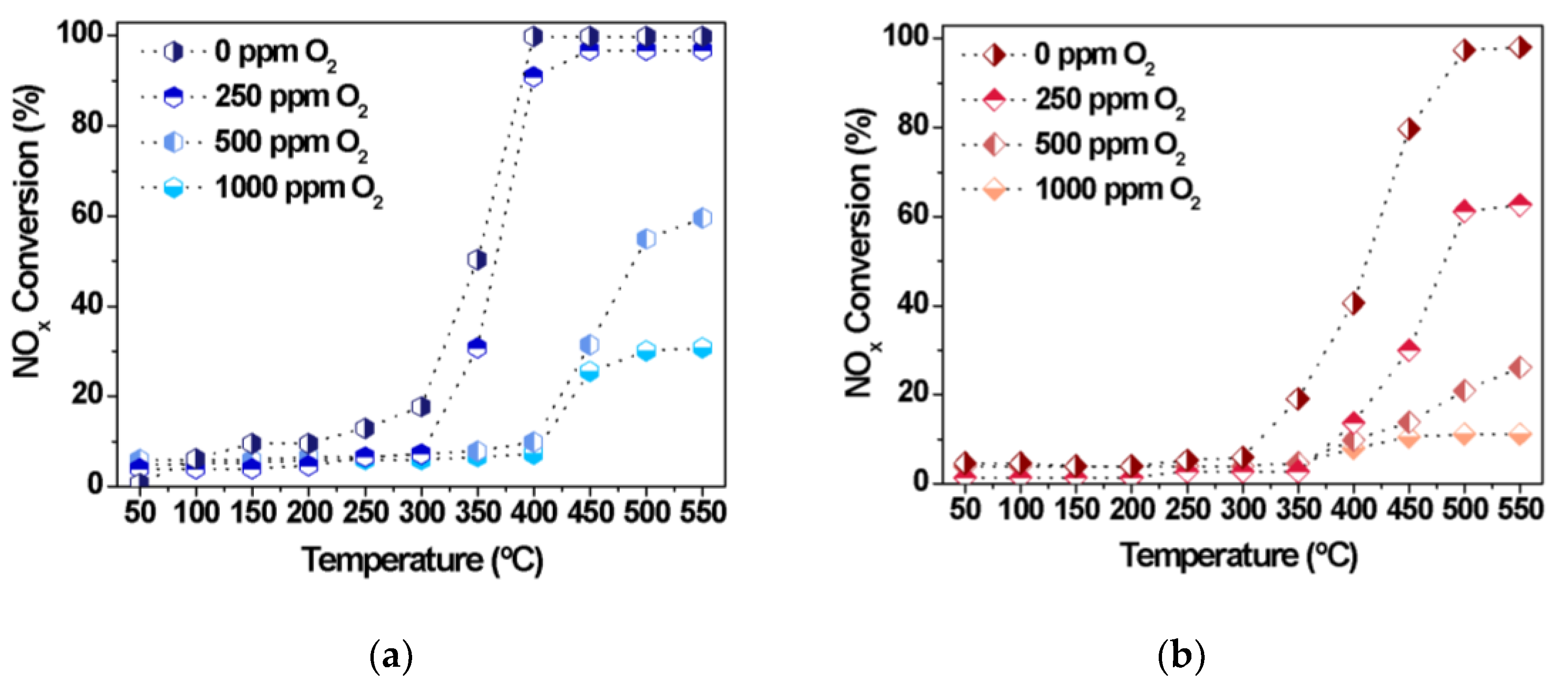

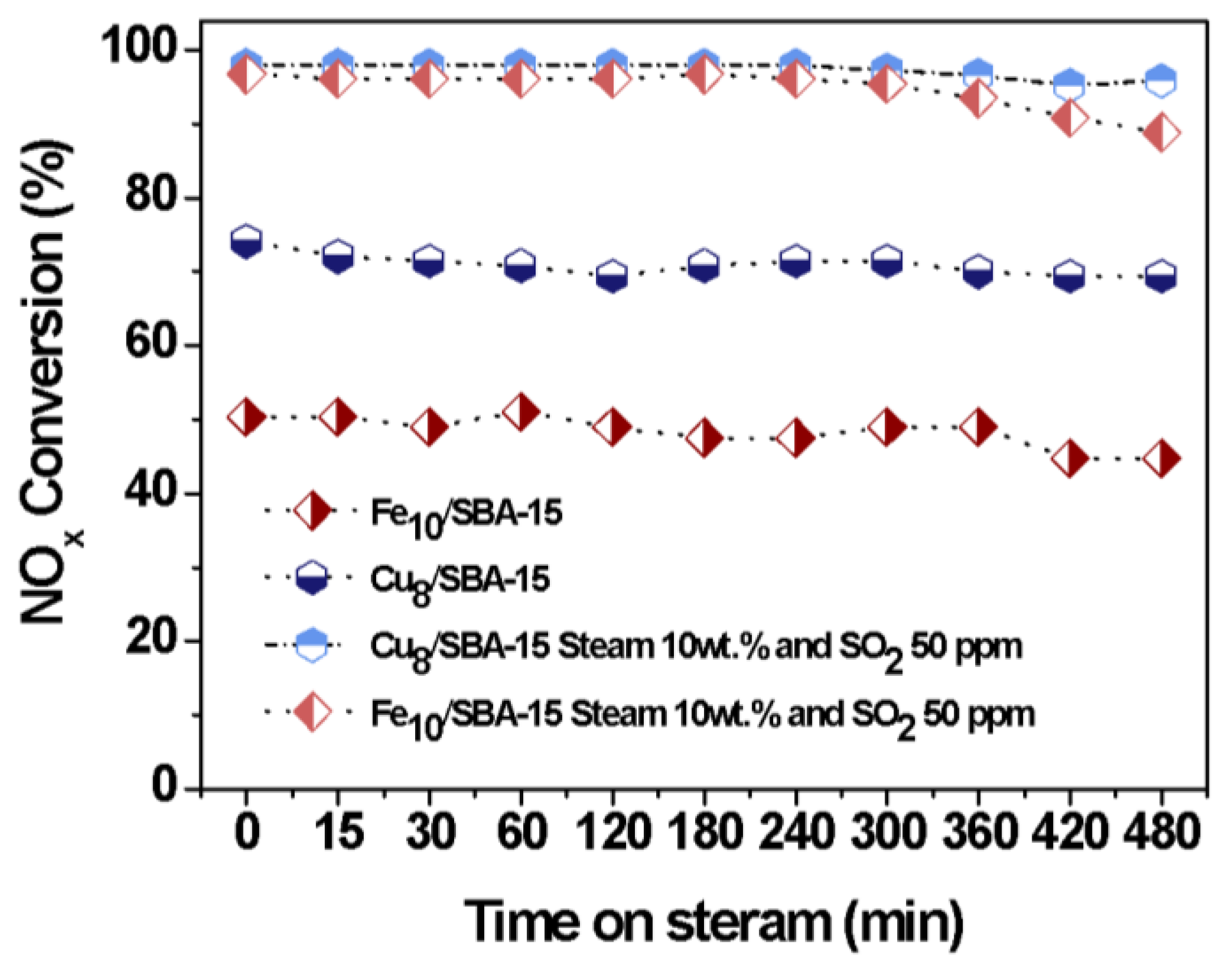
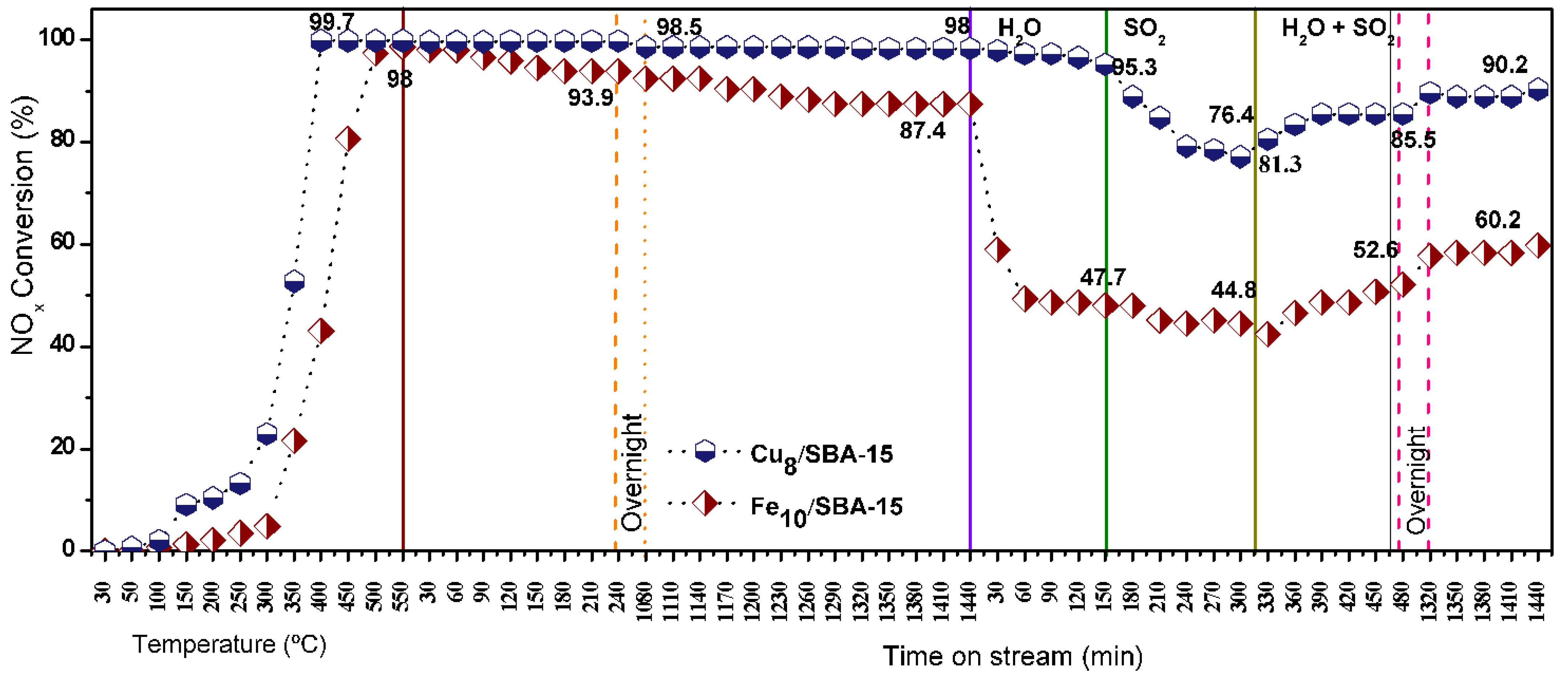
| Sample | Phase through XRD | Particle Size (nm) | a Cu (wt.%) | a Fe (wt.%) | a Cu/Si Molar Ratio | a Fe/Si Molar Ratio | b Metal (wt.%) |
|---|---|---|---|---|---|---|---|
| SBA-15 | Amorphous | - | - | - | - | - | - |
| Cu2/SBA-15 | Amorphous | - | 1.6 | - | 0.015 | - | - |
| Cu4/SBA-15 | CuO | 6 | 2.4 | - | 0.023 | - | 1.2 |
| Cu6/SBA-15 | CuO | 7 | 4.8 | - | 0.047 | - | 5.1 |
| Cu8/SBA-15 | CuO | 9 | 8.9 | 0.090 | - | 7.1 | |
| Fe2/SBA-15 | Amorphous | - | - | 2.7 | - | 0.014 | 2.2 |
| Fe4/SBA-15 | Amorphous | - | - | 3.6 | - | 0.021 | - |
| Fe6/SBA-15 | α-Fe2O3 | 4 | - | 6.1 | - | 0.040 | 4.7 |
| Fe10/SBA-15 | α-Fe2O3 | 4 | - | 10.1 | - | 0.076 | 11.6 |
| Sample | Site | IS (mm·s−1) | QS (mm·s−1) | Width (mm·s−1) | Area (%) |
|---|---|---|---|---|---|
| Fe6/SBA-15 | D1 | 0.25 | 0.81 | 0.41 | 26 |
| D2 | 0.43 | 0.90 | 0.53 | 74 | |
| Fe10/SBA-15 | D1 | 0.24 | 0.80 | 0.40 | 27 |
| D2 | 0.42 | 0.75 | 0.54 | 73 |
| Sample | Si 2p | C 1s | O 1s | Cu 2p3/2 | Fe 2p3/2 | Isat/Imp* |
|---|---|---|---|---|---|---|
| SBA-15 | 103.7 | 284.8 (78) 286.4 (18) 289.0 (4) | 533.0 | |||
| Cu8/SBA-15 fresh | 103.5 | 284.8 (75) 286.3 (19) 288.8 (6) | 530.1 (2) 532.8 (98) | 933.5 936.2 | 0.42 | |
| Cu8/SBA-15 used | 103.4 | 284.8 (75) 286.5 (18) 288.9 (7) | 530.3 (2) 532.8 (98) | 933.8 936.1 | 0.45 | |
| Fe10/SBA-15 fresh | 103.5 | 284.8 (77) 286.5 (18) 288.6 (5) | 530.4 (4) 532.9 (96) | 710.7 | ||
| Fe10/SBA-15 used | 103.5 | 284.8 (78) 286.5 (17) 288.7 (5) | 530.3 (4) 532.9 (96) | 711.0 |
| Sample | C | O | Si | Cu | Fe | M/Si * |
|---|---|---|---|---|---|---|
| SBA-15 | 3.62 | 53.10 | 38.90 | |||
| Cu8/SBA-15 fresh | 4.90 | 51.33 | 37.36 | 4.38 | 0.050 | |
| Cu8/SBA-15 used | 4.76 | 53.08 | 37.81 | 6.41 | 0.076 | |
| Fe10/SBA-15 fresh | 4.93 | 53.03 | 37.38 | 4.35 | 0.058 | |
| Fe10/SBA-15 used | 5.82 | 53.51 | 40.67 | 4.65 | 0.062 |
Disclaimer/Publisher’s Note: The statements, opinions and data contained in all publications are solely those of the individual author(s) and contributor(s) and not of MDPI and/or the editor(s). MDPI and/or the editor(s) disclaim responsibility for any injury to people or property resulting from any ideas, methods, instructions or products referred to in the content. |
© 2023 by the authors. Licensee MDPI, Basel, Switzerland. This article is an open access article distributed under the terms and conditions of the Creative Commons Attribution (CC BY) license (https://creativecommons.org/licenses/by/4.0/).
Share and Cite
Souza, M.S.; Martins, A.J.; Ribeiro, J.A.S.; Campos, A.; Oliveira, A.C.; Jucá, R.F.; Saraiva, G.D.; Torres, M.A.M.; Rodríguez-Castellón, E.; Araujo, R.S. Selective Catalytic Reduction of NOx by CO over Cu(Fe)/SBA-15 Catalysts: Effects of the Metal Loading on the Catalytic Activity. Catalysts 2023, 13, 527. https://doi.org/10.3390/catal13030527
Souza MS, Martins AJ, Ribeiro JAS, Campos A, Oliveira AC, Jucá RF, Saraiva GD, Torres MAM, Rodríguez-Castellón E, Araujo RS. Selective Catalytic Reduction of NOx by CO over Cu(Fe)/SBA-15 Catalysts: Effects of the Metal Loading on the Catalytic Activity. Catalysts. 2023; 13(3):527. https://doi.org/10.3390/catal13030527
Chicago/Turabian StyleSouza, Monique S., Antonio J. Martins, Jackson Anderson S. Ribeiro, Adriana Campos, Alcineia C. Oliveira, Raí F. Jucá, Gilberto D. Saraiva, Marco Antonio M. Torres, Enrique Rodríguez-Castellón, and Rinaldo S. Araujo. 2023. "Selective Catalytic Reduction of NOx by CO over Cu(Fe)/SBA-15 Catalysts: Effects of the Metal Loading on the Catalytic Activity" Catalysts 13, no. 3: 527. https://doi.org/10.3390/catal13030527
APA StyleSouza, M. S., Martins, A. J., Ribeiro, J. A. S., Campos, A., Oliveira, A. C., Jucá, R. F., Saraiva, G. D., Torres, M. A. M., Rodríguez-Castellón, E., & Araujo, R. S. (2023). Selective Catalytic Reduction of NOx by CO over Cu(Fe)/SBA-15 Catalysts: Effects of the Metal Loading on the Catalytic Activity. Catalysts, 13(3), 527. https://doi.org/10.3390/catal13030527






